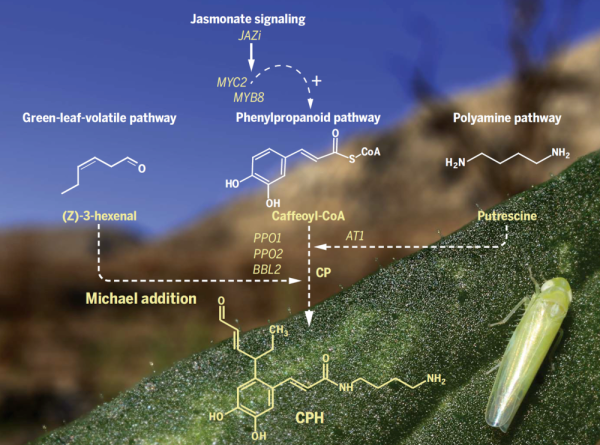Dapeng Li's research team at the Center for Excellence in Molecular Plant Sciences of the Chinese Academy of Sciences, in collaboration with the Max Planck Institute for Chemical Ecology in Germany, revealed for the first time how plants cleverly assemble their specific metabolites to cope with the non-host resistance mechanism of the major agricultural pest leafhopper. On February 4, Beijing time, the relevant research results (Natural history–guided omics reveals plant defensive chemistry against leafhopper pests) were published online in Science in the form of a cover paper. This study opens up a new naturalistic-driven multi-omics analysis method for exploring plant-insect interaction, and provides a new metabolic perspective on how plants can specifically dispatch their chemical "defense barriers" to resist insect attack, which is an important breakthrough in the study of plants' non-host resistance to multi-eating insects. At the same time, the study applied synthetic biology to transform the non-host resistance metabolism of crops for the first time, providing a new feasible application scheme for agricultural precision green prevention and control technology.
Plants are natural experts in organic synthesis, and because they are fixed on the land and cannot escape harm like animals, plants have evolved to be able to generate specific metabolites with complex structures to adapt to their complex and changeable living environment. Dissecting the chemical structure, biosynthetic pathways, physiological and ecological functions of plant-specific metabolites, and how these small molecule compounds function in nature, is to decipher the "chemical language" of plants; the key to explaining how plants arrange and dispatch their complex "metabolic weapons" in the face of adversity to survive in nature is the core of understanding the chemical nature of living organisms. However, due to the complexity and diversity of plant metabolomes, the structure and function of most plant metabolites remain unknown.
Empoasca leafhopper is a worldwide pest that seriously harms crops, its host range is wide, the reproductive rate is high, and more seriously, the leafhopper can spread a variety of plant viruses, causing serious crop yield reductions and economic losses every year. Current control methods are heavy spraying of pesticides, but the control effect is limited and costly. At present, the non-host resistance of plants is concentrated in the study of plant pathogenic bacteria interaction, and the mechanism of plant non-host resistance to insects is not clear due to the high degree of feeding autonomy of insects. Jasmonin is a key hormone in plant insect resistance, and previous studies have found that leafhoppers "eavesdrop" on the synthesis and responsiveness of plant jasmonin hormones, thereby specifically selecting plants with low jasmonin content as their host, but the downstream metabolites regulated by jasmonin that directly exert resistance functions are not clear.
In this study, the team planted a total of 1816 recombinant inbred lines generated by 26 parental hybridizations in the field, and these inbred lines had different genetic backgrounds for the "eavesdropping" of leafhoppers and host selection. When leaflets attack these plants freely, their attack rate can be used to help identify the genetic elements that non-host plants transform into host plants. Using a new analytical approach that combines naturalist-driven forward genetics with reverse genetics, transcriptomics, and non-targeted structural metabolomics, the study identified a new plant-specific metabolite, a key compound in which plants develop non-host resistance to leafhoppers, named CPH. Studies have shown that the compound is specifically regulated by the unconventional jasmonin element, and jaZi is specifically expressed in the attacked leaves only when the plant is attacked by leafhoppers rather than other insects, activating its regulated CPH synthesis. Further studies found that the compound was synthesized by a acetyltransferase AT1, two polyphenol oxidases PPO1 and PPO2, and a berberine bridge enzyme BBL2 in coordination and cooperation. The compound condenses 3 major metabolic pathways, one of which is a key synthetic pathway composed of plant green leaf volatilization pathways, which is the core pathway of plant volatile indirect defense, and the other two pathways are involved in the synthesis of plants' direct defense substances. The study is the first to dissect how a plant's direct and indirect defense pathways subtly "talk and dispatch" to synthesize its metabolic weapons. The research team used synthetic biology to integrate this metabolic pathway into crops such as tomatoes and broad beans, and designed a high-resistance crop that leafhoppers are not host choices.
The Green Revolution in Agriculture in the 1960s increased crop yields. Today, as the population continues to grow, the growing number of droughts, fungal invasions and pests and diseases caused by global warming poses a challenge to future agricultural development. Plants are complex and exquisite chemical designers, and the study's use of naturalistic-driven multi-omics analysis and research methods combined with synthetic biology will provide a new metabolic dimension for the chemical innovation of millions of years of plant evolution, and for the design of the second generation of green revolution high-yield and high-quality stress-resistant crops. In a world of global warming and global herbivores, speculative plant-insect interactions will be the dominant interaction model for natural and man-made ecosystems in the future, and knowledge of how plants respond to this non-host speculative interaction will help us design future green stress-resistant crops that can cope with climate change.

Attacks by leafhoppers induce synthesis and regulatory pathways for key resistant compounds
Source: Center for Excellence in Molecular Plant Science, Chinese Academy of Sciences